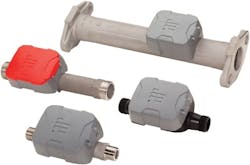How To: Meter Testing: How to Test Electronic Meters
About the author: Jan Boyer is marketing manager for Badger Meter. Boyer can be reached at [email protected].
Solid-state water meters offer innovative, fully electronic metering technology that is designed to reduce maintenance, improve accuracy and durability and minimize water loss. With no moving parts to wear out, electronic meters provide low-flow accuracy and high-flow durability. These meters combine long-term life with dependable long-term accuracy over all flow ranges.
While electronic meters are virtually maintenance free, ongoing meter testing may be required by public utility commissions or other regulatory agencies.
In addition, meter testing is an important part of a utility’s water audit program. Water audits provide utilities with water usage information and help detect leaks in the distribution system. This enables the utility to account for the water that is actually delivered, thereby generating revenue that may otherwise be lost. Meter accuracy is an essential part of any water audit program and the best way to determine that a meter is operating accurately is to test it.
Important Steps
Proper procedures are critical for accurate meter testing:
- Use guidelines such as the American Water Works Assn.’s M6 manual to help reduce testing errors.
- Test benches must be kept clean and in good repair.
- Calibration of flow measurement instrumentation and equipment should be done on a regular basis. Calibration of volumetric tanks, gravimetric scales and reference/master meters should be traceable to national standards.
- Replace any worn gaskets periodically to prevent intrusion into flow passages or leaks.
- Carefully inspect the system for leaks. Leaking joints, control and diversion valves, or drain ports in benches are a common cause for meter testing errors.
- Flush the air from the test bench at the beginning of the test.
- Minimize pressure fluctuations through the system.
- Make sure the meters are completely full of water.
- Mount the meters horizontally or in the vertical up position to ensure pipe and meters remain full.
- Use adequate test quantities to reduce testing errors. See the M6 manual for guidelines or consult the meter manufacturer’s documentation for correct testing quantities.
- To avoid any issues due to turbulence, use the appropriate upstream and downstream straight pipe requirements and always install any reference meters downstream of the meters in test. See the manufacturer’s manual for upstream and downstream straight pipe requirements.
Testing the Meter
These steps provide the proper procedure for testing solid-state electronic flowmeters.
1. Place the meter on the test bench. Clamp the meter securely, but do not tighten more than necessary. Verify that meter bore axes are centered within the test bench piping.
2. Run water through the system to remove any entrapped air. This purging should last roughly one minute, at or near the meter’s maximum rated flow, to ensure the system and meters have been fully purged of air.
3. Record the starting read of the meter.
4. For new meter testing, start with a high-flow test and then proceed down to the lower flows. This ensures that any minor pockets of remaining entrapped air are removed during the first few seconds of the total test sequence. The meter flow tube must be full to avoid an empty pipe condition. For meters pulled from service, the meter internals may need to be fully hydrated prior to the start of testing.
5. Open the test bench discharge valve to the desired flow rate for the maximum flow test.
6. Continue the flow at the maximum flow rate until the meter reaches the desired quantity.
7. Record the results of this test.
8. To determine the accuracy of the meter after each test, divide the consumption indicated by the meter under test by the total tank or reference meter volume.
9. If the meter is not operating within expected standards, repeat the test to verify repeatability. If the second test provides acceptable results, run the test one more time. If the second test does not produce acceptable results, consult the manufacturer’s manual or contact the technical support team.
10. Repeat steps 2 to 8 for intermediate and minimum flow tests. For the minimum flow test in particular, it is important to verify that the actual test flow rate closely matches the target flow rate.
11. When the tests are complete, remove the meter from the test bench.
Other Considerations
- Use adequate test quantities at minimum flow rates. Higher test quantities help eliminate system or test errors.
- When testing multiple meters in sequence, system pressure and spacing between meters may affect testing accuracy.
- Avoid testing electronic meters downstream of other types of meters and provide ample straight piping upstream of each meter. Other types of meters, such as mechanical meters, tested in front of an electronic meter could cause disturbances. Place electronic meters first in the bench test, followed by other types of meters, when multiple types of meters are tested in line.
- Solid-state electronic meters provide a finer reading resolution than most mechanical meters. This provides a more accurate test than visually recording readings of mechanical meters via the position of a test ring. Operators’ understanding of these increased reading resolutions also eliminates preventable errors in recording of testing.
- Insufficient volumes, or not enough resolution on reference meters, can cause testing errors.
- By adjusting the testing procedures to avoid errors caused by insufficient flow volume and/or flow disturbances, utilities may avoid making potentially expensive metering decisions based on inaccurate test data.
Solid-state electronic water meters have become an increasingly popular option for water utilities due to their increased accuracy and reduced maintenance requirements. Should meter testing be required, following accurate testing procedures helps utilities make sound business decisions that can drive increased profitability.
Download: Here
